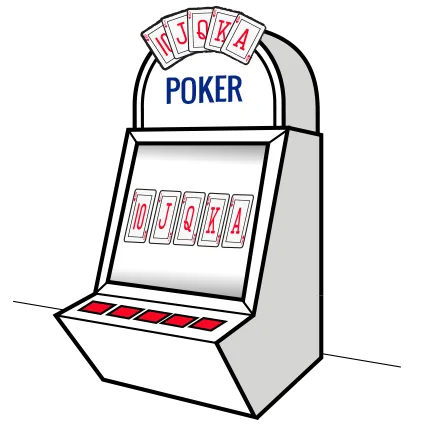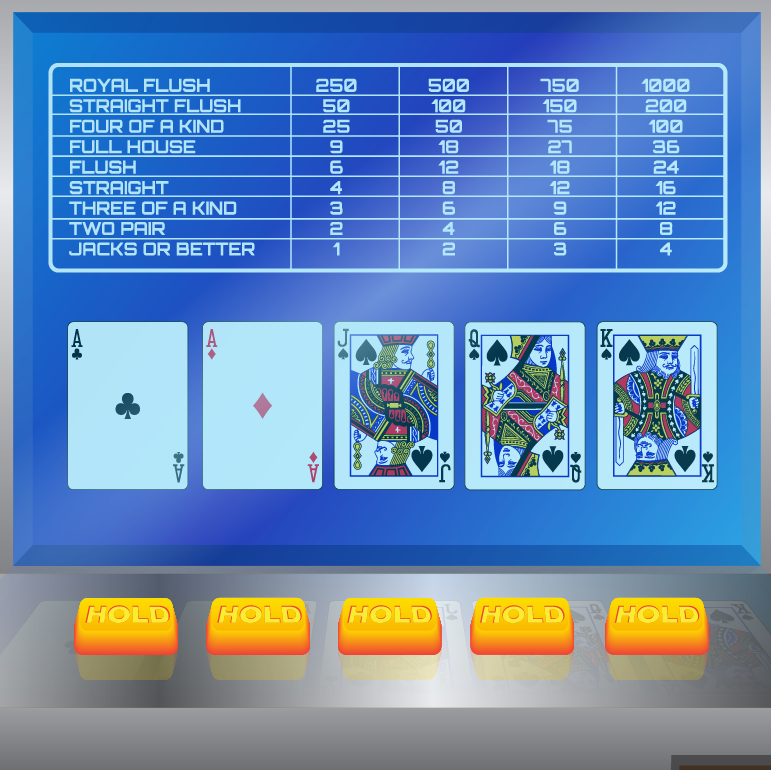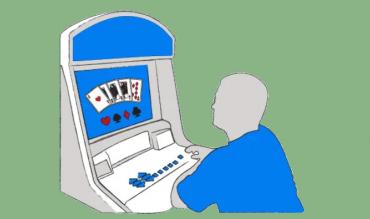Most of the hands that you are dealt in Jacks or Better are a no-brainer. It’s obvious which cards you need to hold, and which ones you should discard. But then there are the not so obvious hands. You know, the ones that contain a low pair and a four-card flush, or worse, a high pair (which pays) along with four cards to the flush. You stare quizzically at the screen trying to figure out what to do with these hands.
Worry no more, because after you read this article you’ll be able to play these confusing hands when they pop up on the screen like a pro. Suppose you are dealt the following hand.
2♦ 3♦ 4♠ 5♥ 3♣
If you look closely, you’ll realize you have two logical plays that you could make:
- Keep the low pair (3♠) and discard the 2, 4 and 5.
- Discard one of the 3♠ and draw one card, hoping to get a straight.
How would you play it?
Any one of a number of popular video poker training software programs can be used to determine which of the above two playing options has a higher average return or Expected Value (EV).
In the above hand, your average return is 82 cents per dollar bet when you hold the 3♠, and only 62 cents per dollar bet if you hold the four-card straight and draw one card. The best play is always the one with the higher EV, which in this case is to hold the pair of 3♠.
If a hand containing a small pair is a better play than holding a four-card straight, then you’ll agree that the same would be true if the hand contained a high pair.
Let’s formulate the above into a simple playing rule for Jacks or Better. (Note: A low pair means a pair of 10s or lower. A high pair means a pair of J’s through Aces.)
Rule #1: If your hand contains any pair and also four cards to a straight, keep the pair.
Take a look at this common hand. How would you play it?
2♥ 3♥ 2♠ 8♥ 9♥
You have two logical plays. You could either:
- Hold the four hearts to try for a flush.
- Keep the pair of 2♠.
The play with the higher EV is to hold the four cards to the flush.
Rule #2: If your hand contains a four-card flush and also a small pair, keep the four flush cards.
What about the case where the hand contains a high pair (rather than a low pair), and four cards to the flush? For example:
J♥ 3♥ J♠ 5♥ 8♥
Would you hold the high pair or the four-card flush? The play with the greater EV is to hold the high pair.
Rule #3: If your hand contains a four-card flush and also a high pair, keep the high pair.
Notice the difference between rules No. 2 and 3. If you have a four-card flush and a low pair, you go for the flush. However, if you have a high pair instead, keep the high pair.
Many players get confused when confronted with a hand that contains either a low or high pair along with four cards to the straight flush. Suppose this hand pops up on your screen; how would you play it?
4♠ 5♠ 6♠ 7♠ 7♣
The play with the higher EV is to hold the four cards to the straight flush.
What if the pair was a high pair such as in this hand?
8♥ 9♥ 10♥ J♥ J♦
Even if you hold a high pair along with a four-card consecutive straight flush, the EV for the four-card straight flush is higher and is, therefore, the better play.
Suppose the four cards to the straight flush were not consecutive but had a gap, such as the following hand.
7♥ 9♥ 10♥ J♥ J♦
Here we have four cards to the straight flush, but with a gap, since only one card — the 8♥ — completes the straight flush hand. However, the play with the greater EV is still to keep the four-card straight flush (with or without a gap) and break up the high pair.
If holding a four-card straight flush is the more profitable play in the above two examples, then, for sure, holding a four-card royal flush would also be the more profitable play. This leads to rule No. 4.

Rule #4: If your hand contains a four-card straight flush or royal flush (with or without gaps) and either a low or high pair, always keep the four-card straight flush or royal flush.
As you can imagine, most of the time that you hold four cards to a royal flush, you should discard the odd card and go for the royal. The only time you should not do this is if your hand also contains a five-card, made, straight flush as follows.
9♦ 10♦ J♦ Q♦ K♦
In this example, you should hold all five cards for an immediate straight flush payout of 250 coins.
Rule #5: If your hand contains four cards to the royal flush, always go for the royal except if your hand also contains a paying five-card straight flush.
Here’s another tricky hand. Suppose you are dealt the following.
J♥ Q♥ A♥ 5♥ K♥.
How would you play it? Most players would hold the paying five-card flush for an immediate 30-coin payout (assuming you wagered five coins). However, that would be a mistake. The hand with the higher EV is to hold the four-card royal flush.
Rule #6: If you are dealt a hand containing a four-card royal flush and a paying flush (or paying straight), go for the royal flush.
The next grouping of hands usually causes players fits. These are hands that contain only two or three high cards and nothing else. For example, how would you play this hand?
4♣ 7♣ J♦ Q♥ A♥
The correct play is to hold only the suited Ace and Queen (yes you should discard the Jack).

Rule #7: If your hand contains three high cards, keep the two suited high cards and discard the unsuited high card.
What if your initial hand contains three unsuited high cards such as
4♣ 7♣ J♦ Q♥ K♠?
As a general rule, you should hold all three unsuited high cards. The exception is if one of the high cards is an Ace, in which case you would discard the ace and hold the other two unsuited high cards. (The main reason you toss the Ace is you will make more straights, and the possibility for a full house and four of a kind.)
Rule #8: If your hand contains three unsuited high cards, keep all three high cards except discard the ace.
Usually, if your hand contains nothing but a single high card, you should just keep it and draw four cards. However, you need to pay attention if your hand also contains a 10. If it does and it is the same suit as the high card (J, Q, K only), then you should keep the suited high card and the 10 and draw three cards.
10♠ 7♥ 9♦ 5♣ Q♠
In the above hand, holding the suited Q-10 has a higher EV than holding just the Q. (Note: You should never hold a suited Ace-10, just hold the Ace.))
Rule #9: If your hand contains a suited 10 and either a J, Q, or K, keep the suited 10 and picture card.
Look at the following hand. How would you play it?
3♣ 9♦ 5♣ 10♥ 7♣
Most players would discard all five cards and draw five new ones. However, that would be a mistake. Look carefully at the hand. Do you see a three-card straight flush with two gaps? Holding the 3♣5♣7♣ has a slightly higher EV than tossing all five cards.
Rule #10: Before you toss all five cards because the hand doesn’t contain any high cards or other playable cards, check to be sure it doesn’t contain a three-card straight flush with two gaps. If so, hold the latter.
